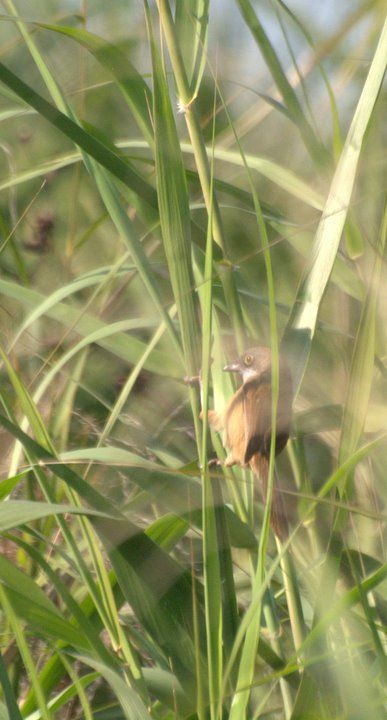| Citation |
BirdLife International 2017. Chrysomma altirostre (amended version of 2016 assessment). The IUCN Red List of Threatened Species 2017: e.T22716326A111106627. https://dx.doi.org/10.2305/IUCN.UK.2017-1.RLTS.T22716326A111106627.en. Downloaded on 10 February 2020. |
Description |
JUSTIFICATION
This species is likely to be in rapid decline as a result of the extensive loss of tall, wet grassland habitat, primarily owing to drainage, conversion to cultivation and grazing by domestic stock. It therefore qualifies as Vulnerable.
RANGE DESCRIPTION
This species occurs in three disjunct populations, along the River Indus and its tributaries in Pakistan, in the terai of Nepal (where it is a very rare and local resident, known from just two highly disjunct localities [Inskipp et al. 2016]), and the Brahmaputra floodplain in north-east India (BirdLife International 2001). Recent surveys in Assam and Arunachal Pradesh, India in 2015-2016 found the species in Kaziranga, Orang, Manas, Dibru-Saikhowa and Majuli in Assam, and D’Ering Wildlife Sanctuary in Arunachal Pradesh (A. Rahmani in litt. 2016). In 2012, 33 individuals were discovered in Harike Wildlife Sanctuary, Punjab, India (Sawant and Sudhagar 2013). It is known historically from the Irrawaddy-Sittang plains of Myanmar, and in 2014 the species was rediscovered near Udo in the Yangon region of Myanmar (Rheindt et al. 2014), with a further 2-4 sites discovered in the Irrawaddy delta since the rediscovery (F. E. Rheindt in litt. 2016). It is possibly also known historically from Bangladesh but there are no recent records. Recent records from Assam, its stronghold in India, suggest it has declined and in Pakistan it is uncommon and local.
DESCRIPTION
The population is estimated to number 2,500-9,999 mature individuals based on an assessment of known records, descriptions of abundance and range size. This is consistent with recorded population density estimates for congeners or close relatives with a similar body size, and the fact that only a proportion of the estimated Extent of Occurrence is likely to be occupied. This estimate is equivalent to 3,750-14,999 individuals in total, rounded here to 3,500-15,000 individuals.
Trend Justification: Despite a lack of recent data on population trends, a rapid decline is suspected to be continuing, consistent with rates of habitat loss throughout the speciess range. In Assam, the speciess stronghold in India, recent records suggest the population has undergone a massive decline (Rahmani 2012).
HABITAT AND ECOLOGY
It is a presumed resident, inhabiting river floodplain tall grassland and reedbeds (2-4 m high), often seasonally inundated or in close proximity to rivers and pools, and predominantly comprising species of Imperata, Saccharum, Phragmites and Typha. It prefers dense, contiguous, undisturbed stands of grass and generally avoids drier, semi-open, short grassland habitat with scattered bushes. It is unobtrusive and usually encountered in pairs or small groups.
THREATS
Large tracts of natural swamps and wet grassland have been destroyed or degraded throughout its range as a result of drainage, conversion for agriculture and grazing by domestic stock. This has been exacerbated in Pakistan by the construction of large barrages on the Indus, accelerating rates of land reclamation and conversion to cultivation. The proposed construction of a large number of dams in the foothills of Arunachal Pradesh poses a signficant threat to the speciess grassland habitats (R. Das in litt. 2016). Most remaining habitat is subject to intense pressure from further drainage for agriculture, human encroachment, excessive burning and cutting, domestic livestock-grazing, and, more locally, commercial forestry plantations. The political situation in Myanmar has largely precluded intensive surveys for the species.
CONSERVATION ACTIONS
Conservation Actions Underway
In Nepal the species has been assessed as Critically Endangered (Inskipp et al. 2016). It occurs in several protected areas, including Kaziranga, Manas and Dibru-Saikowa National Parks, India, Sukla Phanta Wildlife Reserve and Chitwan National Park, Nepal.
Conservation Actions Proposed
Conduct further surveys to establish the speciess current distribution and status, particularly in Myanmar and Bangladesh. Protect the small area of grassland where the species has been rediscovered in Myanmar (Rheindt et al. 2014). Campaign for increased representation of swamps and wet grasslands within protected-area systems throughout its range. Identify the most important conservation sites for the species and conduct research into grass burning/harvesting regimes in order to develop optimum management strategies. Regulate harvesting of grass, overgrazing and encroachment at key sites, particularly within protected areas. Conduct education programmes throughout its range to promote grassland conservation and regeneration. |

